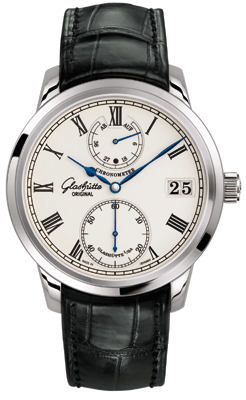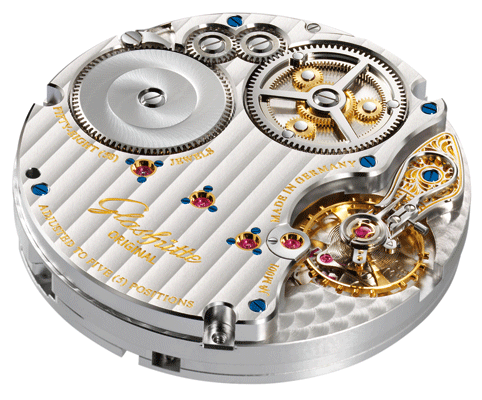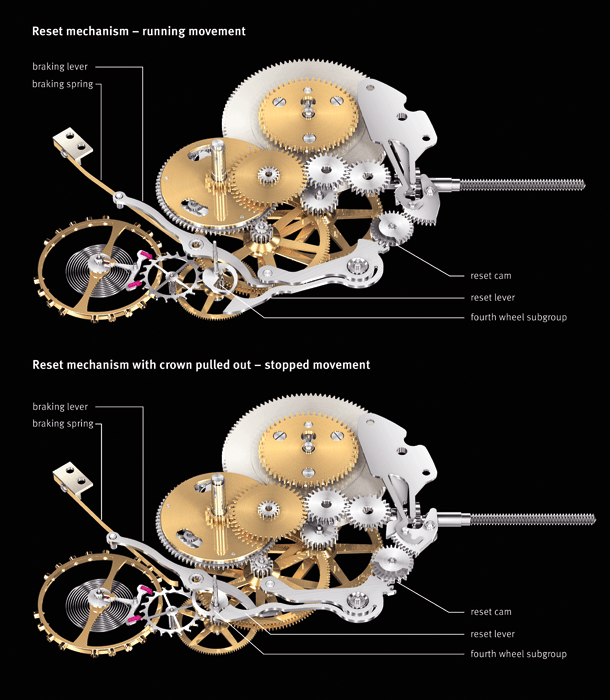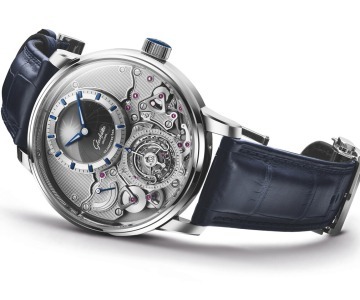 Le terme « chronomètre » désigne une montre particulièrement précise telle que celles qui furent indispensables par le passé pour déterminer le temps nécessaire à la navigation maritime et aérienne. De nos jours, comme par le passé, des instituts officiels indépendants contrôlent la régularité de la précision de la marche de ces garde-temps grâce à des procédures de mesure normalisées. Seul un garde-temps accompagné d’un certificat émanant d’un institut agréé peut être appelé chronomètre.
Le terme « chronomètre » désigne une montre particulièrement précise telle que celles qui furent indispensables par le passé pour déterminer le temps nécessaire à la navigation maritime et aérienne. De nos jours, comme par le passé, des instituts officiels indépendants contrôlent la régularité de la précision de la marche de ces garde-temps grâce à des procédures de mesure normalisées. Seul un garde-temps accompagné d’un certificat émanant d’un institut agréé peut être appelé chronomètre.
Il va sans dire que l’intégralité des calibres remontés à la main est testée à Glashütte Original selon ces critères stricts : le chronomètre Senator est le premier garde-temps comportant cette confirmation officielle sous forme d’un certificat.La synchronisation précise des aiguilles des minutes et des secondes a maintenant été possible en modifiant le calibre 58-01 à remontage manuel qui fait fonctionner le chronomètre Senator. Un mécanisme original de remise à l’heure/d’arrêt des secondes permet à l’utilisateur de régler aisément l’heure exacte. Lorsqu’on tire sur la couronne, l’affichage de l’heure s’interrompt et l’aiguille des secondes saute en position de départ où elle reste tandis que l’aiguille des minutes se place simultanément sur la minute entière suivante. Quand l’heure est réglée en faisant pivoter la couronne, l’aiguille des minutes s’arrête uniquement sur l’indication de la minute entière garantissant ainsi toujours le bon rapport entre les minutes et les secondes affichées.
L’aspect classique du cadran du chronomètre Senator rappelle l’agencement caractéristique d’un chronomètre de poche. Le cadran en argent accueille la petite seconde et la réserve de marche s’affiche le long de l’axe central. Cette dernière, située à 12 heures, indique fidèlement l’énergie restante jusqu’à l’heure. La date panorama distinctive de Glashütte Original se trouvant à 3 heures comporte désormais une amélioration sophistiquée créée par les designers de la manufacture permettant à l’affichage de la date de changer instantanément à minuit précis. Le mouvement arbore par ailleurs maintenant un indicateur jour/nuit qui facilite plus encore le réglage de l’heure en relation avec le changement de date : de 6h à 18h, le petit cercle situé entre l’indicateur de réserve de marche et le centre du cadran est blanc et, de 18h à 6h, il est noir.
Le cadran en argent présente une surface richement contrastée pour la grande minute bleuie et polie et les aiguilles des heures en forme de glaive. Affichant une attention particulière pour le détail, l’arbre de l’aiguille est évidemment poli à la main. Les designers de Glashütte Original ont positionné la date panorama à 3 heures. Une échelle des minutes meulée, rappelant le chemin de fer, encercle l’affichage central de l’heure du Chronomètre Senator d’une manière parfaitement harmonieuse et les chiffres romains, eux aussi meulés, contribuent à l’aspect véritablement classique de ce garde-temps.
Un processus de manufacture somptueux entre dans la fabrication de la surface apparemment simple du cadran. Glashütte Original a consciemment opté pour l’emploi d’une tradition d’époque appelée argenture grainée. La première étape de ce procédé consiste à polir la surface du cadran en laiton avec un mélange composé d’eau, de craie et de bois. Puis, une pâte contenant des poussières d’argent et de l’eau est soigneusement appliquée à la main sur la surface polie. Le résultat est un charmant cadran d’aspect pur qui attire l’œil de l’observateur comme par magie en raison de la structure raffinée de la surface.
 Un dos de boîtier en verre saphir anti-reflets protège le calibre 58-01 remonté manuellement et présente le mouvement finement travaillé : ceci est un exemple attrayant de l’horlogerie de Glashütte avec sa platine trois-quarts, des chatons en or vissés et un coq moderne gravé à la main. A noter les rouages planétaires nouvellement conçus qui commandent l’affichage du mouvement de la réserve de marche. Ce garde-temps élégant dispose d’une réserve de marche de 45 heures.
Un dos de boîtier en verre saphir anti-reflets protège le calibre 58-01 remonté manuellement et présente le mouvement finement travaillé : ceci est un exemple attrayant de l’horlogerie de Glashütte avec sa platine trois-quarts, des chatons en or vissés et un coq moderne gravé à la main. A noter les rouages planétaires nouvellement conçus qui commandent l’affichage du mouvement de la réserve de marche. Ce garde-temps élégant dispose d’une réserve de marche de 45 heures.
Ce chronomètre Senator simple et impressionnant à la fois est disponible en or rose ou blanc ; il tient parfaitement en place au moyen d’un bracelet noir en alligator de Louisiane doté d’un fermoir pliant pour un port sûr et confortable.
 The term “chronometer” denotes an especially accurate watch, such as those that were necessary in the past for determining the time needed for sea and air navigation. Today, just as in the past, official independent institutes test the exacting level of rate precision of these timepieces utilizing standardized measuring procedures. Only with certification from an authorized institute is a timepiece allowed to be called a chronometer. It goes without saying that at Glashütte Original all manually wound calibers are tested according to these strict criteria: the Senator Chronometer is the first timepiece with official confirmation in the form of a certificate.Precise synchronization of the minute and second hands has now been made possible by re-designed Glashütte Original manual winding Caliber 58-01, which powers the Senator Chronometer model. A novel stop-seconds/reset mechanism allows the wearer to set the precise time with ease. Pulling the crown stops the time display and causes the second hand to jump to the beginning position, where it remains; the minute hand moves simultaneously to the next full minute. When the crown is then turned to set the time, the minute hand stops only on the indication of the full minute, thus always guaranteeing the correct relationship between the minutes and seconds displayed.
The term “chronometer” denotes an especially accurate watch, such as those that were necessary in the past for determining the time needed for sea and air navigation. Today, just as in the past, official independent institutes test the exacting level of rate precision of these timepieces utilizing standardized measuring procedures. Only with certification from an authorized institute is a timepiece allowed to be called a chronometer. It goes without saying that at Glashütte Original all manually wound calibers are tested according to these strict criteria: the Senator Chronometer is the first timepiece with official confirmation in the form of a certificate.Precise synchronization of the minute and second hands has now been made possible by re-designed Glashütte Original manual winding Caliber 58-01, which powers the Senator Chronometer model. A novel stop-seconds/reset mechanism allows the wearer to set the precise time with ease. Pulling the crown stops the time display and causes the second hand to jump to the beginning position, where it remains; the minute hand moves simultaneously to the next full minute. When the crown is then turned to set the time, the minute hand stops only on the indication of the full minute, thus always guaranteeing the correct relationship between the minutes and seconds displayed.
The classic appearance of the Senator Chronometer’s dial is reminiscent of the characteristic layout of a pocket chronometer. The silver dial is home to subsidiary seconds and power reserve displays along the central axis; the latter, located at 12 o’clock, loyally displays the energy remaining to the hour. The characteristic Glashütte Original panorama date display located at 3 o’clock now contains a sophisticated enhancement created by the manufactory’s designers enabling the date display to instantly change precisely at midnight. The movement now also sports a day/night indicator that makes setting the time in relation to the date change even easier: From 6:00 am until 6:00 pm the small circle located between the power reserve indicator and the center of the dial is white, and from 6:00 pm until 6:00 am it is black.
The silver dial provides a richly contrasting surface for the polished, blued sweep minute and pear-shaped hour hands. Displaying a typical attention to detail, the hand arbor is, of course, hand polished. A milled railroad chapter ring encircles the Senator Chronometer’s central time display in a perfectly harmonious way, and the milled Roman numerals add to the timepiece’s genuinely classic appearance.A lavish manufacturing process goes into making the dial’s seemingly simple surface. Glashütte Original consciously opted to employ a vintage tradition: a technique known as l’argenture grainée, a frosted silver plating.
The first step in the process consists of machine-blasting the surface of the brass dial with a mixture of water, chalk, and wood. Then a paste containing silver powder and water is carefully applied by hand to the blasted surface. The result is a charmingly purist dial that magically attracts the observer’s eye with its refined surface structure.
An antireflective sapphire crystal case back protects manually wound Caliber 58-01, showcasing the finely finished movement, which is an eye-catching example of Glashütte watch making with its three-quarter plate, screw-mounted gold chatons, and hand-engraved balance cock. Of special note are the newly developed planetary gears that control the display of the movement’s power reserve. This elegant timekeeper has a power reserve of 45 hours.
The simple, yet impressive, Senator Chronometer is available in either rose or white gold, and is held in place perfectly by a black Louisiana alligator skin strap with a folding clasp for a secure and comfortable fit.

